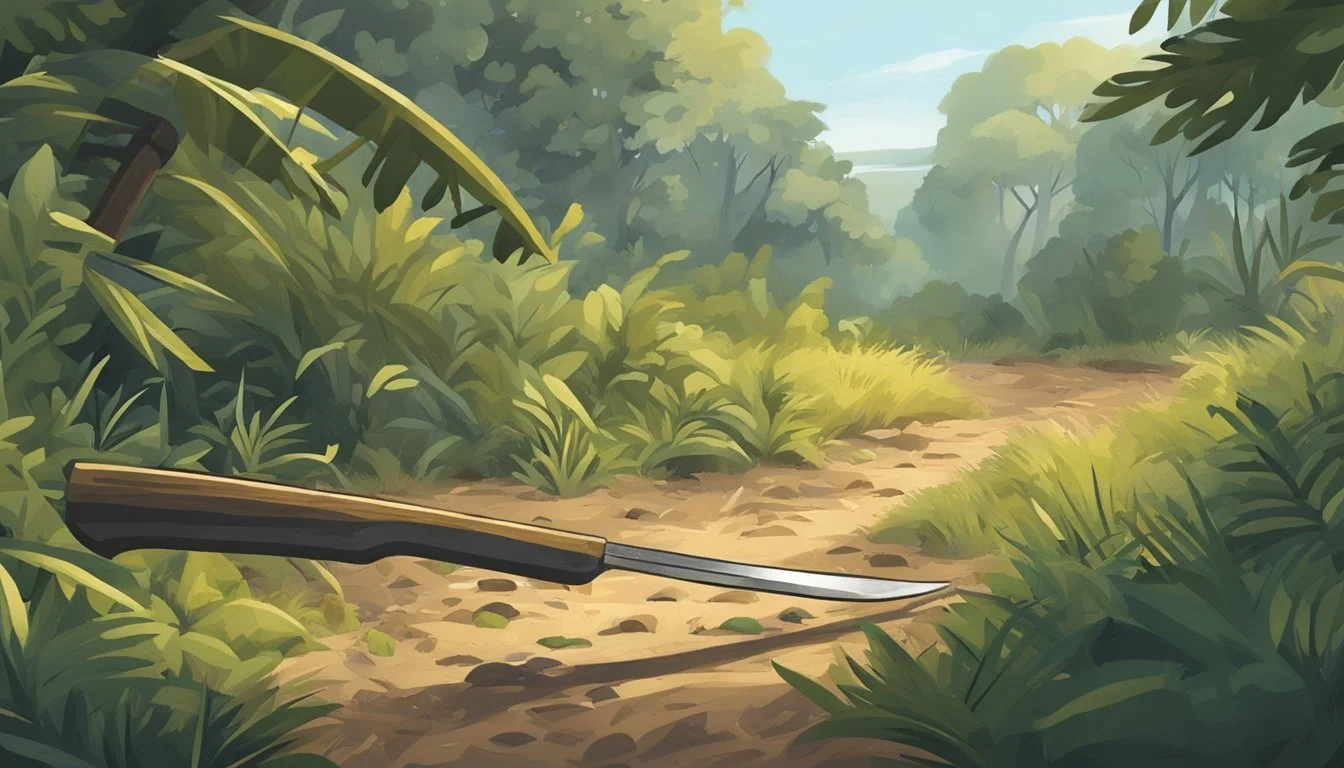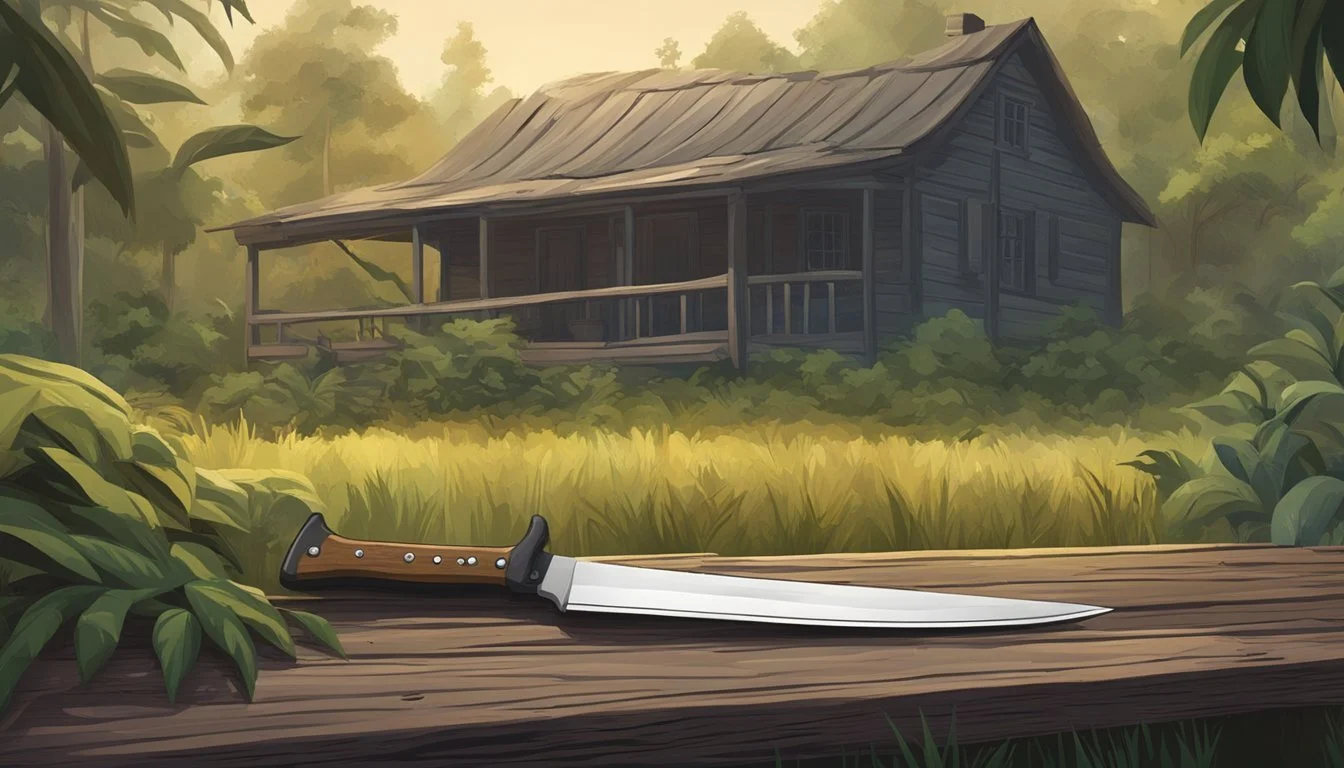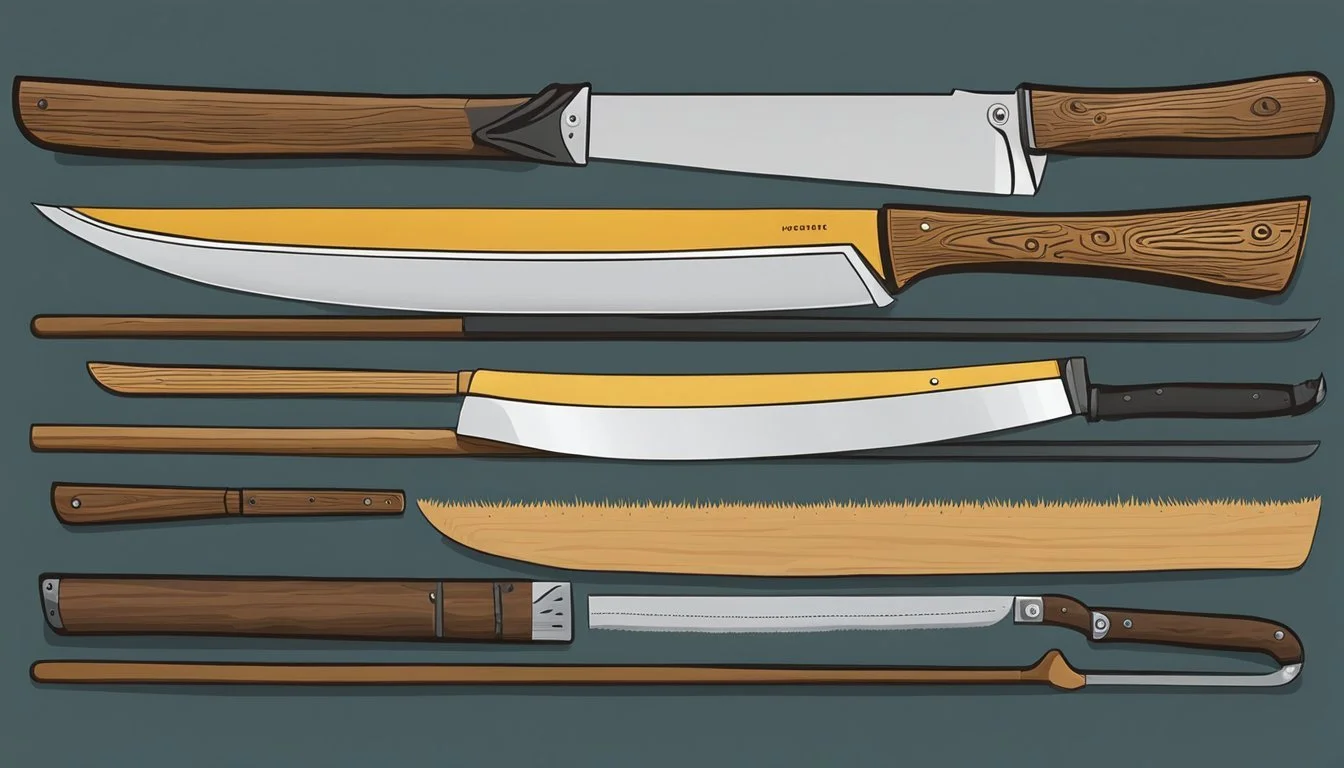The Ultimate Guide to Using a Machete for Clearing Brush and Vegetation
Effective Techniques for Homesteaders
A machete is a versatile tool that serves as an invaluable asset for anyone looking to manage vegetation on their homestead. With a broad blade designed for chopping, it is particularly effective for clearing brush, cutting through woody stems, and managing overgrowth. When utilized correctly, a machete can streamline the process of transforming dense thickets into manageable land. Its effectiveness is rooted in the proper technique, which involves swinging the blade at an angle to slice through vegetation with ease, rather than hacking directly through it. This method reduces the number of strikes needed and enhances the blade's longevity.
When preparing to clear land with a machete, safety and efficiency are paramount. The machete should be held firmly to maintain control, and the blade should be swung close to the ground to maximize the effectiveness of each cut. This not only ensures a clean swath through the underbrush but also helps to maintain a safe working environment by reducing the risk of injury. The design of the machete, often with a curved blade, prevents it from sticking in dense growth, making the task of clearing land less labor-intensive and more efficient.
Choosing the right machete is also critical to effectively manage homestead vegetation. The market offers various types tailored for specific tasks, such as cutting tree trunks, navigating through bamboo thickets, or creating trails. Factors such as blade length, weight, and handle design can significantly impact the tool's utility and the user's fatigue. Thus, selecting a machete that compliments both the task at hand and the user’s physical capabilities is essential for sustainable land management practices.
Historical Overview and Evolution of the Machete
The machete, with its storied past and utility, has evolved from primitive cutting implements to a quintessential tool for agriculture and survival. This evolution is marked by significant strides in design and application across various cultures.
Defining the Machete and Its Origins
The machete is a broad-bladed tool that can be described as a crossover between a knife and a sword, drawing comparisons to the medieval falchion due to its shape. Its history begins with the earliest human civilizations, where ancestors fashioned sharp tools from stones. The term "machete" began to circulate in the late 1500s with Spanish influence. However, the concept of a large cutting tool has ancient roots.
The Machete's Role in Agriculture and Survival
In agriculture, machetes have been indispensable for tasks such as cutting sugar cane, clearing brush, and harvesting crops. In many regions globally, they became a survival tool, aiding in the collection of food and construction of shelters. They could also be used for self-defense, accentuating their importance beyond farming. In contemporary homesteads, machetes continue to be a reliable ally for managing vegetation and contributing to the self-sufficiency of those living off the land.
Types of Machetes and Their Unique Designs
The variety of machete types is a testament to its versatility in tasks ranging from agricultural to survival situations. Each design's blade shape and size are crafted to suit specific vegetation and brush-clearing needs effectively.
Comparing Blade Shapes and Sizes
Machetes come in several blade shapes and sizes, each offering advantages for different tasks. For instance:
Parang Machetes: These typically feature a distinctive, curved blade shape resembling a scimitar, ideal for cutting woody vegetation. The blade is long and thick, making it durable for tough vegetation.
Bush Machetes: These have a straight back and a weighted blade ideal for heavy cutting action needed to clear brush. Their versatility makes them a go-to for a variety of homestead clearing tasks.
Bolo Machetes: Recognized by their bulbous tip, Bolo machetes are designed with a center of gravity towards the end of the blade, enhancing chopping power for thick vegetation.
Specialized Machetes for Different Tasks
Each type of machete can be particularly suited for diverse tasks due to its unique design:
Parang Machetes: They excel in cutting through thick brush and limbs with precise, powerful strokes. Originating from Indonesia, their design is specific to the needs of the dense jungles.
Bush Machetes: Featuring an extended, sometimes heavyweight blade, these machetes are perfect for general brush clearing, trail cutting, and are designed to be effective in dense vegetation.
Bolo Machetes: Originating from the Philippines, their hefty front end works exceptionally well for agricultural tasks such as slicing through sugar cane and bamboo shoots.
The blade length of these machetes varies, generally falling between 10 to 28 inches, allowing users to choose based on the precision or power they need for the task at hand. Whether for taming a sprawling yard or maintaining walking paths, selecting the right machete design will streamline the work.
Material and Construction: Choosing Your Machete
When selecting a machete, understanding the nuances of blade material and handle construction maximizes both efficiency and longevity. The right choice ensures a durable tool that can withstand the rigors of clearing brush and vegetation.
Steel Composition: Carbon vs. Stainless
Carbon Steel:
Pros:
Sharper edges: Capable of retaining a keen edge longer, aiding efficient cutting.
Ease of Sharpening: Easier to sharpen in the field with minimal tools.
Cons:
Prone to rust: Requires meticulous care and maintenance to prevent corrosion.
Stainless Steel:
Pros:
Corrosion resistance: Well-suited to humid and wet environments due to rust resistance.
Cons:
Edge retention: Generally holds an edge for a shorter period compared to carbon steel.
Handle Materials: Comfort and Durability
Wooden Handles:
Pros:
Aesthetics: Offers a classic look and natural feel.
Grip: Tends to provide a secure grip when properly maintained.
Molded Plastic and Micarta:
Pros:
Maintenance: Less upkeep required, especially in differing weather conditions.
Versatility: Often designed ergonomically for comfort over extended use.
Importance of Full Tang Construction
Full Tang: The blade metal extends through the handle, greatly enhancing durability and providing balance.
Visible Tang: This refers to the tang being noticeable as it goes down the handle, a sign of quality construction and reliability in demanding situations.
Machete Features and Functionalities
When selecting a machete for clearing brush and vegetation, understanding the specific features and functionalities is crucial. Each design element enhances the tool's effectiveness for particular tasks and provides safety and comfort during use.
Blade Design Elements: Groove, Thickness, and Edge
Groove: A pronounced groove in a machete blade helps to reduce the weight and can contribute to an improved balance, making the tool easier to handle during long periods of use.
Blade Thickness: The thickness of the blade affects its durability and strength. Generally, a blade of around 2.5 mm to 3 mm thickness provides a good balance between heft and agility for chopping through dense vegetation.
Edge: A sharp edge is essential for clean cuts. The edge should be honed to a utility edge, which is less acute than a razor edge but sufficiently sharp for efficiently slicing through brush.
Handles and Grip Styles for Different Uses
Grip Styles: The grip of a machete can significantly impact maneuverability. Handles often come in different materials such as rubber, hardwood, or polymer, each offering distinct levels of comfort, grip, and durability.
Soft Grip: Ideal for reducing hand fatigue during extended use.
Hardwood Grip: Provides a classic feel and can enhance precision and control.
Ergonomic Design: Some machete handles are ergonomically contoured to reduce slippage and increase control, vital for long stints of clearing work.
Additional Features: Guard, Sawback, and More
Guard: A guard on a machete serves as a safety feature to protect the user's hand. An integral crossguard can prevent the hand from sliding onto the blade during vigorous chopping.
Sawback: Machetes with a sawback blade feature have teeth on the reverse side of the blade, making them multipurpose tools. This feature allows for sawing through tougher, woodier stems that may not be easily sliced with the blade edge.
Lanyard Hole: A hole for attaching a lanyard helps ensure the machete stays with the user even in rigorous activity, offering an extra measure of security.
Coating: Some blades come with a black anti-corrosive coating which provides both protection from the elements and a non-reflective surface, beneficial for both maintenance and tactical considerations.
Preparing for Use: Safety Equipment and Considerations
Engaging in brush and vegetation clearing with a machete necessitates proper preparation. The user must prioritize safety by wearing appropriate gear and selecting a machete that aligns with their physical capabilities.
Essential Protective Gear for Safe Handling
Before using a machete, it is imperative to don the necessary safety equipment. At a minimum, the user should wear:
Gloves: A pair of sturdy gloves, preferably leather, to protect the hands from blisters, cuts, and potential impact injuries.
Eye Protection: Safety goggles or glasses to shield the eyes from flying debris.
Leg Protection: Long pants, ideally made of a heavy material, to guard against scratches and cuts to the lower limbs.
It is crucial that the chosen gear fits well and does not hinder the user's movement or dexterity, as this could compromise their ability to handle the machete safely.
Choosing the Right Size and Weight for the User
The efficiency and safety of using a machete are greatly influenced by the size and weight of the blade. A user should consider the following specifics when choosing their tool:
Blade Length and Weight: Ensure the machete's length and weight are manageable; too heavy or too long could lead to fatigue and loss of control.
User's Strength and Stature: The machete should match the user's physical strength and stature. A well-balanced machete reduces strain on the user's muscles and joints, enabling more prolonged use with less risk of injury.
Effective Techniques for Clearing Brush and Vegetation
Clearing brush and vegetation requires a systematic approach to ensure safety and efficiency. This section covers specific strategies for different types of vegetation and tackled advanced techniques for managing more challenging growth such as woody brush and small trees.
Best Practices for Clearing Different Types of Vegetation
Grass and Grassy Brush: For thinner, non-woody vegetation like grass and grassy brush, it's best to use sweeping, horizontal strokes. Ensure that the machete is sharpened to avoid getting stuck and to achieve a clean cut.
Tall Grasses: Taller grasses may need a more robust, two-handed swing, cutting at the base near the ground.
Vines and Weeds: When clearing vines and weeds, use a hook-shaped blade if available. This blade can reach around vines and pull them away from trees or structures with a single pulling motion.
Thick Vines: For very thick vines, several angled chops may be required to sever them completely.
Advanced Techniques for Tougher Brush and Small Trees
Woody Brush and Thickets: To handle woody brush and thickets, one should chop at a diagonal angle. This technique allows for better penetration and makes it easier to slice through the material rather than merely pushing it aside.
Chart for Blade Angles:
Material Type | Recommended Angle
Woody Brush | 45 degrees
Thickets | 45 degrees
Small Trees: For small trees, one should first clear the surrounding brush. Using a 45-degree angle, make a V-cut at waist height, cutting into the trunk on both sides. This allows for more control over the direction of the fall.
Note: For trees with a thicker trunk, sequential notches around the circumference may be necessary before the final cut can be made safely.
Maintaining Your Machete
A well-maintained machete ensures efficiency and longevity. The user must regularly clean, sharpen, and store the tool appropriately to protect it from rust and corrosion, thus maintaining its performance and safety.
Routine Cleaning and Sharpening Techniques
After each use, one should clean the blade with soapy water and dry it thoroughly to remove sap, dirt, and debris. For sharpening, it's recommended to use a whetstone or file. Begin by securing the machete and running the whetstone along the blade's edge at a consistent angle of 10-20 degrees. Continuous, fluid motions achieve the best results, and regular sharpening will keep it ready for the next task.
Preventing Rust and Corrosion
To prevent rust, users should treat the machete's blade with a light coat of oil after each cleaning session. Preferred oils include:
Mineral oil
WD-40
Gun oil
A thin coat creates a barrier against moisture and air, two primary factors leading to corrosion. Regular inspections for any signs of rust can catch issues early, before they compromise the integrity of the machete.
Proper Storage Solutions
Storage plays a vital role in maintaining a machete's condition. One should store the tool in a dry environment to further prevent rust. Use a sheath, preferably made of breathable materials like canvas or leather, which offers protection and reduces exposure to damp conditions. A dedicated space, such as a tool rack or cabinet, will prevent unnecessary contact with other items that could dull the blade or cause injuries.
Practical Applications Beyond Brush Clearing
Machetes serve a myriad of purposes outside their traditional role in brush clearing. They shine as multifunctional tools in agriculture for harvest and landscaping as well as reliable survival instruments.
Machetes in Agriculture: Harvesting and Landscaping
In agriculture, the machete is a key asset for harvesting a variety of crops. Its sharp blade is ideal for cutting sugar cane, trimming vegetation, and other harvesting chores with precision.
Harvesting Tasks:
Sugar cane
Rice
Corn
Landscaping is another area where machetes prove beneficial. With their ability to maneuver through thick vegetation, they are excellent for sculpting landscapes and maintaining trails.
Landscaping Utilization:
Sculpting hedges and bushes
Trail maintenance
Cutting back overgrowth
The Machete as a Versatile Survival Tool
As a survival tool, the machete is both versatile and robust. It can assist in creating shelter by cutting branches and can be a key instrument in procuring food, whether by hunting or by preparing traps.
Survival Functions:
Shelter construction
Food procurement
Defense against threats
Its multipurpose nature makes it indispensable for survival scenarios, providing a single tool solution for numerous tasks.
Choosing the Best Machete for Your Needs
When selecting the perfect machete for clearing brush and vegetation, one must consider factors that influence performance, comfort, and durability.
Factors to Consider: Weight, Length, and Use Case
The effectiveness of a machete is greatly impacted by its weight and length, which should be matched with the intended use case.
Weight: Heavier machetes excel in chopping through thick vegetation due to the additional force they provide. However, a lighter machete reduces fatigue over prolonged use.
Length: Longer blades offer a greater reach, which is beneficial for clearing large areas, but shorter blades afford more control and are easier to maneuver in dense growth.
Machetes forged from high carbon steel are preferred for their resilience and ability to maintain a sharp edge. However, one should be aware that high-carbon steel can be more susceptible to corrosion if not properly maintained.
Personal Preferences in Machete Selection
Personal preference plays a significant role in choosing the best machete. Handle ergonomics, blade shape, and balance all contribute to a machete's functionality and should align with the user's comfort and handling requirements. Some might prefer the traditional versatility of a straight-backed blade, while others might opt for specialized types like the bolo for their distinct chopping advantage.
Recommendations from Machete Specialists
Machete specialists often recommend specific models based on performance and user feedback. For a versatile option, the Gerber Gator is frequently suggested due to its durable construction and comfortable grip. The Gerber Double Down, on the other hand, is noted for its unique compact folding design, useful for portability and convenience.
Brand: Gerber, Model: Gator, Notable Feature: Rubberized grip for control
Brand: Gerber, Model: Double Down, Notable Feature: Folding blade for compact storage
Brand: TOPS Knives, Model: El Chete, Notable Feature: Best for survival scenarios
Brand: Tramontina, Model: Bush Machete, Notable Feature: Preferred for clearing brush
Material: British Steel, Recommendation: High Carbon, Benefit: Holds sharp edge, but needs care
Consulting with experienced users and reading reviews can lead to an informed decision tailored to one's specific environment and tasks.
Conclusion: Integrating the Machete Into Homestead Chores
On the homestead, a machete proves to be a quintessential tool for efficient outdoor management. When tasked with clearing brush, its sharp and durable blade offers a robust solution, excelling in the clearing of overgrown vegetation. It is designed to be both lightweight and portable, which allows for ease in carrying it across various terrains.
For more delicate tasks such as cutting palms, a machete's precision comes into play. The user can wield the tool with confidence, knowing that its design allows for controlled and clean cuts that preserve the natural aesthetics of the environment.
Table of Machete Attributes for Homestead Tasks:
Lightweight: Enhanced maneuverability
Sharpness: Precise cutting of thick brush
Portability: Ease of transport
Durability: Suitable for frequent use
Versatility: Applicable to a variety of jobs
To integrate the machete into daily homestead chores, one should establish a routine for its maintenance and storage. After each use, cleaning the blade ensures longevity and preparedness for the next job. The tool should be stored securely, away from elements that could degrade its condition.
In essence, a machete is not just a tool but an extension of a homesteader’s hand. It fits naturally into the rhythm of outdoor chores, enhancing productivity and contributing to the overall management of the homestead.







